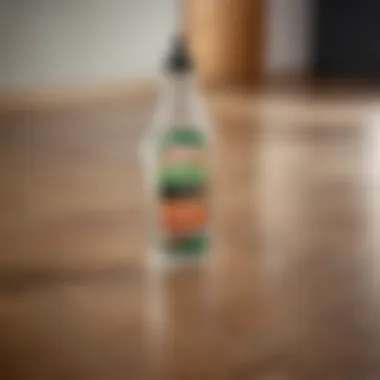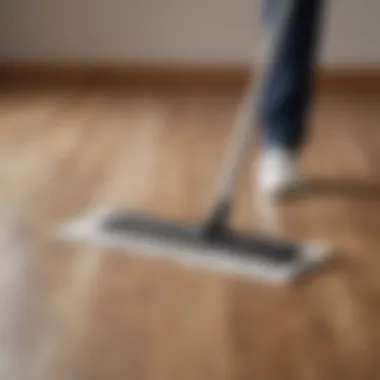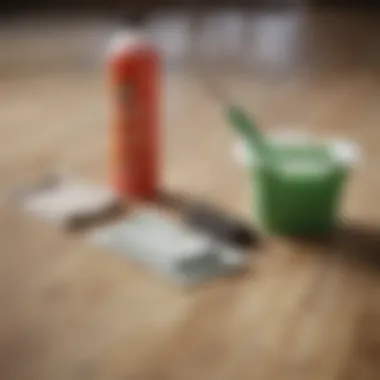Effective Methods for Cleaning Laminate Floors


Intro
Recipe Overview
While the term "recipe" typically pertains to cooking, in this context, it will refer to the essential steps and components for creating an optimal laminate floor cleaning solution. Understanding what goes into your cleaner, much like understanding ingredients in cooking, is paramount.
Cleaning Solution Overview
The following section will breakdown cleaning solutions that can be used to maintain laminate flooring, reviewing both homemade and commercial options. This will empower you to choose the right method that fits your needs and preferences.
Ingredients
Homemade Cleaners
- White vinegar - 1 cup
- Water - 1 gallon
- Dish soap - a few drops (optional for extra cleaning power)
Commercial Cleaners
- Bona Hard-Surface Floor Cleaner - known for its effectiveness on laminate
- Zep Neutral pH Floor Cleaner - designed to avoid damage to the laminate surface
- Rejuvenate All Floors Restorer - used for maintaining the shine
Special Notes on Ingredients
- White vinegar serves as a natural disinfectant. It is effective in cutting through grime and is safe for laminate surfaces.
- When opting for commercial products, it is crucial to check that they are specifically labeled for laminate floors to avoid any potential damage.
Cleaning Techniques
To ensure the longevity of your laminate floors, the cleaning technique you choose is as important as the cleaner itself.
- Dusting Sweeper - Regularly use a dry dust mop or sweeping tool to gather any loose dirt or debris. This prevents scratching the surface when mopping later.
- Damp Mopping - Using the vinegar and water solution, lightly dampen a clean mop or cloth. Never soak the floor, as excess water can warp and damage laminate flooring.
- Spot Cleaning - For stubborn stains, apply a small amount of homemade solution directly to the spot and gently scrub with a soft cloth.
- Drying - After cleaning, use a dry microfiber cloth to wipe down areas and prevent moisture buildup.
Important Note: Always avoid using steam cleaners on laminate flooring. The heat and moisture can cause permanent damage.
Culmination
Maintaining laminate floors doesn't need to be complicated. By understanding effective cleaning solutions, optimizing cleaning techniques, and using the appropriate products, anyone can keep their laminate surfaces shining and elegant for years to come.
Understanding Laminate Flooring
Understanding laminate flooring provides a foundational knowledge necessary for properly maintaining and cleaning these surfaces. Many homeowners choose laminate due to its aesthetic appeal and affordability. However, incorrect cleaning methods can lead to damage, diminishing the overall quality of the flooring. Therefore, grasping the unique characteristics of laminate flooring is essential for effective upkeep.
Composition and Structure
Laminate flooring consists of several layers, which are fused together during manufacturing. The top layer is a transparent wear layer that protects against scratches, stains, and fading. Below this, a design layer showcases various patterns and colors, giving the impression of wood or stone. The core layer, often made from high-density fiberboard (HDF), offers stability and durability, while the bottom layer, or backing, acts as support and moisture resistance. Understanding this composition helps in determining the appropriate cleaning methods to preserve the floor’s integrity.
Benefits of Laminate Floors
Laminate floors are favored for their versatility and ease of maintenance. They come in a variety of styles and finishes, making them suitable for different interior themes. Another significant benefit is the ease of installation; many laminate options are designed for floating installation, which means they can be placed over existing floors without the need for glue or nails. Additionally, laminate is often more affordable compared to traditional hardwood, thus appealing to a wider audience. It's also resistant to moisture to some extent, making it a practical choice for areas prone to spills.
Common Misconceptions
There are several misconceptions regarding laminate flooring that can affect maintenance choices. One common belief is that laminate can be treated like traditional hardwood. In reality, laminate surfaces are not meant to be sanded or refinished. Another misconception is that all cleaning products are safe for laminate. In fact, using harsh chemicals or abrasive tools can lead to irreversible damage. Proper education on these myths is crucial for effective care and cleaning of laminate floors.
"Understanding the nuances of laminate flooring helps ensure a long-lasting and visually appealing surface."


By grasping the essential components, benefits, and misconceptions associated with laminate flooring, readers can make informed decisions regarding their cleaning methods. This knowledge lays the groundwork for exploring effective cleaning solutions that enhance the durability and appearance of their floors.
Ideal Cleaning Methods for Laminate Floors
The condition of laminate floors can greatly affect the overall appearance of a space. Knowing the right cleaning method is essential. It ensures that the beauty of laminate flooring is preserved while protecting it from damage. Choosing effective cleaning methods goes beyond aesthetics; it influences the longevity of the flooring itself. For those who aim for a clean, well-maintained home, understanding these methods is a necessity.
Overview of Cleaning Methods
Cleaning laminate floors requires special consideration. Common floors can handle various cleaning solutions, but laminate needs gentle treatment. Regular cleaning involves sweeping or vacuuming to remove dirt and dust. For deeper cleaning, mopping is crucial, but it must be done properly. Too much water can damage protective layers, so using a damp mop is recommended. Employing the right methods will prevent wear and safeguard the integrity of the materials.
Using Commercial Cleaners
Using commercial cleaners is advantageous for many homeowners. These products are specifically formulated for laminate flooring, making them effective against dirt and grime. They often contain specialized ingredients that help in maintaining the floor’s shine without causing harm. Choosing a reputable commercial cleaner can yield excellent results with minimal effort.
Types of Commercial Cleaners
There are several types of commercial cleaners available. Some cleaners are all-purpose, ideal for various surfaces. Others are specific to laminate flooring. The key characteristic that sets them apart is their pH balance. Many laminate cleaners have a neutral pH, which means they clean without damaging the finish. It's a popular choice, as it effectively tackles everyday stains without leaving residue.
However, users must be cautious of products claiming to restore shine. Some may contain strong chemicals that could harm laminate surfaces in the long run.
How to Choose the Right Product
Choosing the right product involves understanding your specific floor needs. Look for cleaners designed explicitly for laminate floors; this ensures safety and effectiveness. One should also read labels to check for harmful ingredients. Many recommend products that are eco-friendly as they are generally safer for the environment and family. Weighing these factors can dictate the outcome of the cleaning experience, enhancing the overall cleanliness and appearance of the flooring.
Also, knowing how the product reacts with certain stains can help in decision making.
Application Techniques
Proper application techniques can change the effectiveness of cleaning. Using a microfiber mop is highly recommended because it traps dirt effectively without scratching surfaces. Mist the cleaner onto the mop or directly on the floor, but avoid saturating the laminate. This technique helps to keep floors shiny while maintaining their texture. Users should also ensure that they follow the product instructions closely, as this can maximize the benefits while minimizing any potential damage.
Homemade Cleaning Solutions
Many homeowners opt for homemade cleaning solutions due to their accessibility and often economical nature. These solutions can be tailored to meet individual preferences and are effective in cleaning laminate flooring.
Ingredients for Effective Cleaners
The choice of ingredients is crucial in homemade cleaners. Common components include vinegar and water, or a mix of baking soda with water. These ingredients are gentle yet effective. Vinegar's acidity helps break down dirt and grime without harming the laminate. The benefit of choosing these ingredients is their natural cleaning properties and availability in most households. However, it's important to use vinegar in moderation, as too much can damage the flooring finish over time.
Step-by-Step Recipe for Homemade Solutions
Creating a simple homemade cleaner is straightforward. For a basic solution, mix one part vinegar with three parts water in a spray bottle. Shake gently and spray onto a microfiber cloth or the mop. This ensures even application, which is important when cleaning laminate. Experimenting with different proportions helps to find the right balance for specific cleaning tasks. Following this recipe allows homeowners to achieve a clean floor without the hassles of strong chemicals.
Advantages of Using Homemade Cleaners
Using homemade cleaners offers many advantages. First, they are often more cost-effective than store-bought options. Second, they allow for customization based on individual needs, including fragrance preferences or specific cleaning challenges. Additionally, homemade solutions often avoid the harsh chemicals present in many commercial products. This approach is beneficial for households with children or pets. However, it’s essential to understand that not all homemade cleaners are universally effective. Some stains may require specialized treatments beyond simple household ingredients.
Step-by-Step Cleaning Process
A systematic approach to cleaning laminate floors is essential to maintaining their aesthetic and functional qualities. The Step-by-Step Cleaning Process ensures that each stage is addressed effectively, reducing the risk of damage while enhancing the floor's appearance. Proper preparation, employing the right techniques, and following up with maintenance can significantly extend the life of laminate flooring. Each specific aspect of this process plays a critical role in achieving a thorough and safe clean.
Preparation Before Cleaning
Gathering Necessary Supplies


Gathering necessary supplies is the first step in preparing for laminate floor cleaning. This phase contributes largely to the overall success of the cleaning process. Basic supplies should include a soft broom or vacuum cleaner designed for hard floors, a mop, and an appropriate cleaning solution. The key characteristic of this preparation is the selection of non-abrasive tools and cleaners to avoid damaging the surface. Ensuring the right tools promotes efficiency and minimizes damage risks, which is a vital aspect of keeping laminate floors pristine. The unique feature of this preparation stage is that it sets the foundation for a hassle-free cleaning session, preventing interruptions caused by last-minute searches for tools.
Assessing Floor Condition
Assessing the floor condition is another crucial component before diving into the cleaning process. This assessment allows one to identify specific problem areas, such as scratches or heavy stains, that may require special attention. The key characteristic of this step is the ability to adapt cleaning methods based on the floor's current state. Considering this assessment is beneficial because it helps prioritize which areas require more intensive care. The unique feature lies in its foresight, as understanding the floor condition aids in selecting the most effective cleaning techniques that suit its needs, thus enhancing the efficiency of the overall cleaning process.
Cleaning Techniques
Mopping Without Excess Water
Mopping without excess water is a critical technique to maintain the integrity of laminate floors. Laminate is susceptible to water damage, so this method is essential to prevent warping or swelling. The key characteristic of this technique is a controlled amount of moisture applied during mopping. This is a beneficial choice because it ensures that the floor dries quickly, thereby minimizing potential water damage. The unique feature of this mopping technique is the use of a damp mop, rather than a soaking wet one, which helps lift dirt without introducing excessive moisture that could compromise the floor.
Spot Cleaning Stains
Spot cleaning stains is an effective way to address unwanted marks on laminate floors promptly. This technique allows for targeted cleaning of problematic areas without requiring a full floor wash. The key characteristic of spot cleaning is its focused and efficient approach. Engaging in this practice is popular because it helps maintain the overall appearance of the floor with minimal effort. The unique aspect of this method is its flexibility; it can be customized depending on the stain's nature, whether it be food or liquid, making it an essential part of any cleaning routine.
Drying Methods
Choosing the right drying method is crucial after cleaning laminate floors. Air drying is typically preferred due to its gentleness on the surface. The key characteristic of this method is that it is both non-invasive and effective. This choice is beneficial, as it helps prevent moisture build-up, which can lead to damage over time. The unique feature of air drying is its natural process, which does not require any additional tools or substances, making it easy and efficient.
Maintenance After Cleaning
Routine Cleaning Schedule
Establishing a routine cleaning schedule is vital to maintaining the cleanliness and durability of laminate floors. Regular cleaning helps in keeping dirt and grime at bay, making deep cleaning less strenuous. The key characteristic of a routine cleaning schedule is its consistency. Following a regular plan is beneficial as it prevents build-up, ensuring the floor looks its best at all times. The unique aspect is that it can be tailored based on foot traffic; for instance, areas with high foot traffic may require more frequent attention.
Recommended Products for Maintenance
Selecting recommended products for ongoing maintenance is essential to preserving laminate floors. Utilizing cleaners specifically formulated for laminate ensures safety and effectiveness. The key characteristic of choosing the right products is their ability to clean without causing harm. This is a beneficial choice for maintaining a fresh look and extends the floor's lifespan. The unique feature lies in recognizing the importance of using products that will not leave residues or damage the finish, ultimately creating a safer environment for both the flooring and the occupants.
Common Challenges in Cleaning Laminate Floors
Cleaning laminate floors comes with its own set of challenges. Understanding these challenges helps homeowners effectively maintain their flooring without causing damage. Laminate floors are attractive and durable, but they can be sensitive to certain cleaning methods and substances. Recognizing how to tackle common issues can enhance the lifespan and visual appeal of laminate surfaces. This section dives into prevalent problems, from stubborn stains to the risk of potential damage during cleaning. By addressing these points, readers will gain insight into effective strategies that will keep their floors looking their best.
Dealing with Stubborn Stains
Types of Stains and Their Treatment
Stains on laminate flooring can arise from various sources such as spills, pets, or everyday wear. Common stains include food, drink, and dirt marks. Each stain type requires a specific approach. For example, water-based stains usually respond well to vinegar solutions, while oil-based stains may need a more special treatment.
The key characteristic of understanding treatment types is knowing that quick response is essential. For untreated stains, they may set and become much harder to remove. A popular choice in methods involves using a soft cloth soaked in a gentle cleaner. This preserves both the laminate and the floor's finish. Certain options may carry risks if misapplied, such as excessive moisture use.
Advantages of recognizing the stain type include tailored cleaning that can effectively remove the stain without necessitating harsher chemicals that could degrade the laminate surface over time. By knowing the stain types, homeowners can handle their cleaning efficiently.
Preventive Measures
Taking proactive steps can significantly reduce the occurrence of stubborn stains. Protective measures entail using mats at entryways and immediately cleaning spills. A key characteristic includes the routine maintenance that prevents dirt build-up and possible staining.
This section of cleaning is beneficial, especially for busy households with children and pets. Preventive measures are often the less expensive choice, as they can avoid more extensive cleaning needed later. Unique features involve developing habits such as regular vacuuming and immediate stain treatment, leading to long-term ease in upkeep.
Despite their advantages, these measures require diligence and a slight time investment. Over time, however, they contribute to maintaining the laminate's surface with minimal intervention.
Avoiding Damage During Cleaning


Risks of Using Wrong Products
Cleaning products that are not compatible with laminate floors often lead to deterioration. This might include harsh chemicals or products that promote excess moisture. Such risks can manifest as warping, discoloration, or dulling of the finish. An important characteristic of understanding product risks is realizing that not all cleaners are suitable for every surface.
Choosing the right product is crucial for maintaining the integrity of laminate flooring. Many commercial cleaners might claim effectiveness, but not all are formulated specifically for this synthetic material. A thorough understanding of product labels helps users avoid potential issues.
Understanding these risks allows readers to safeguard their flooring while still achieving cleanliness. Investing in suitable products remains a beneficial choice to enhance the lifespan of laminate floors without the fear of damage.
Tips for Safe Cleaning Practices
Establishing safe cleaning practices is essential for maintaining the quality of laminate flooring. Recommended tips include using a damp cloth instead of soaking the floor. It is crucial to avoid abrasive materials, which could scratch the surface.
A key characteristic of these practices involves adhering to moderate moisture levels during cleaning. Liquid pooling can cause long-term harm. Therefore, techniques such as dry mopping or using a slightly damp microfiber cloth can efficiently clean surfaces without risking damage.
Following safe practices is both a beneficial and cost-effective choice. Homeowners will save money on repair costs caused by improper care. The unique benefit of this information is that it encourages users to adopt habits that lead to more confidence in cleaning their laminate flooring.
Additional Tips for Extending the Life of Laminate Floors
Taking care of laminate floors goes beyond standard cleaning techniques. It involves appropriate protective measures and conditioning to enhance durability. These practices can prevent premature wear and tear, ensuring that the flooring remains visually appealing and functional over time. Here we explore significant tips that can contribute to preserving your laminate floors.
Protective Measures
Using Rugs and Mats
Using rugs and mats is one of the simplest yet most effective ways to protect laminate floors. These additions can serve as a barrier against scratches, scuffs, and general wear. They are especially effective in high-traffic areas, like entryways and living rooms.
The key characteristic of rugs and mats is their ability to absorb dirt and moisture. This prevents these elements from being transferred onto the laminate surface, which can lead to staining or ugly marks. Choosing high-quality mats that feature non-slip backing enhances their effectiveness and safety. This practice not only guards against physical damage but also keeps the floors cleaner.
There are downsides, however. If rugs are not maintained or cleaned regularly, they can accumulate dirt and grime, which might transfer to the laminate flooring. Additionally, not all rugs are suitable for use on laminate surfaces, as some can cause discoloration or damage over time. Opting for breathable and non-abrasive materials can help mitigate these risks.
Avoiding Heavy Furniture Scenarios
Heavy furniture can place excessive pressure on laminate flooring, leading to permanent indentations or damage. To avoid such risks, it is essential to reconsider furniture arrangements and make conscious choices about what weight and types of furniture are placed on the laminate surface.
A key characteristic of this preventive measure is the use of protective pads under furniture legs. These pads can significantly reduce pressure points and help distribute weight evenly. This adjustment not only protects the floor but also makes it easier to move furniture without causing scratches.
However, one should be mindful of certain limitations. If furniture is consistently moved or dragged across the floor, even with pads, issues may arise. Periodically checking the placement of these protective pads ensures they remain effective. Noticing any wear and replacing them when needed can prevent damages.
Conditioning the Surface
Conditioning the surface of laminate floors is an important yet often overlooked aspect of maintenance. Regularly applying a suitable laminate floor cleaner helps in keeping the surface in good condition. This practice removes debris and prevents residue build-up. Conditions like fading or loss of shine can be minimized with consistent care.
With these tips, laminate floors can remain beautiful and functional for many years. Taking the time to implement protective measures and proper conditioning allows homeowners to enjoy their laminate flooring without the worry of permanent damage or the need for early replacement.
Closure
Maintaining laminate floors requires a thoughtful approach. This article has delved into various aspects of cleaning methods suited for laminate surfaces, underscoring the importance of proper maintenance. Effective cleaning not only preserves the aesthetic appeal but also prolongs the lifespan of the flooring.
Recap of Effective Cleaning Methods
To summarize the key cleaning methods discussed:
- Commercial Cleaners: Selected cleaners specifically designed for laminate are effective. They reduce streaks and avoid damaging the finish. Ensure to choose products that are free from harsh chemicals.
- Homemade Solutions: Simple mixtures, typically involving vinegar and water, are an eco-friendly way to clean. They can be tailored based on personal preferences and available ingredients.
- Technique Matters: Methods such as dry mopping, minimal water use during cleaning, and quick drying techniques are vital. All these factors play a role in maintaining the integrity of the laminate flooring.
Final Thoughts on Laminate Floor Care
Caring for laminate floors goes beyond just cleaning. It's essential to consider routine maintenance practices to keep the floors looking pristine over time. Regular sweeping, along with a well-defined cleaning schedule, can prevent the buildup of dirt and grime.
Remember that prevention is key; using rugs in high-traffic areas and being mindful of furniture movement can help reduce wear and tear.
Ultimately, an informed approach to cleaning and maintaining laminate floors will ensure their durability and beauty for years to come. This comprehensive guide aims to make the cleaning process effective and straightforward.







